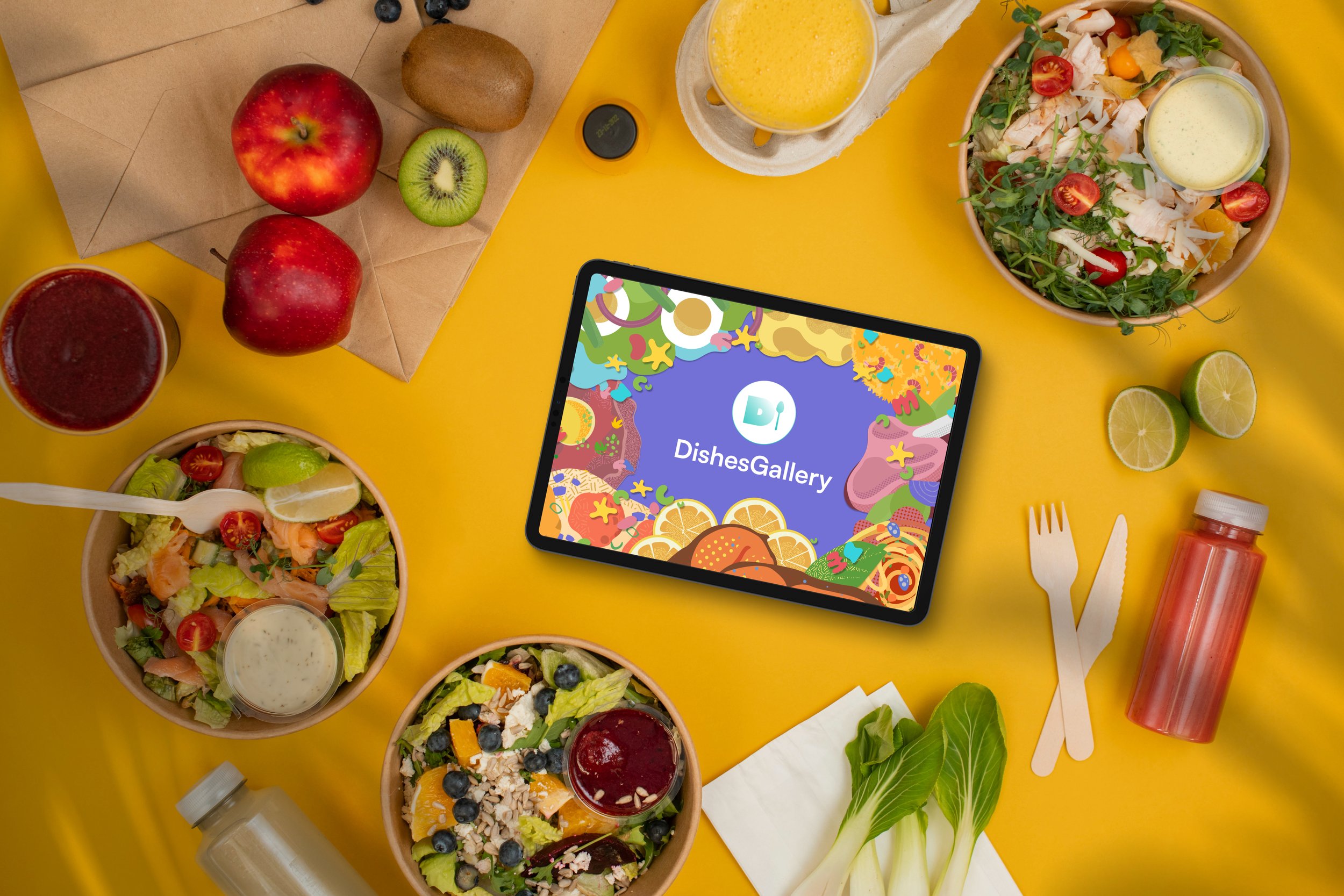
DishesGallery
01 - PROJECT BRIEF
DishesGallery is a multifunctional interactive service system that utilizes computer AI image generation technology to enhance visual information delivery through a gallery of tasty cuisines. It also includes a set of 3 modules of interactive tables and chairs that are linked to the service system, on iPads. When dining out, customers can freely choose dining habits to increase sharing and interactivity while providing convenient management and service processes for restaurant owners and staff.
Project Timeline
Sep - Dec 2023
Project Type
Service Design
Project & Role
Individual Project
Tools
Figma, Adobe software (Illustrator and Photoshop), Rhinoceros 3D, & Vray
02 - OVERVIEW
Problem
As a food enthusiast, dining out brings joy, but the ordering process could be challenging. Limited information during dish introductions and discrepancies in descriptions could be disappointing. The absence of visual aids on menus and the language complexities of the cultural cuisines may confuse customers.
The overall dining out experience, including uncertainties about portion sizes and discomfort when dining out, needs improvement.
Based on the research, I’ve also noticed a lack of organized digital systems in restaurants for tracking restaurant management, including dining tables, staff, and planned & ongoing cuisine processes.
Solutions
I’ve designed a multifunctional service design system that brings convenience to restaurant management while improving customers' dining-out experience.
03 - THE OUTCOME
KEY FEATURE 1Visualized Ordering Experience for Dining Out Customers
Turning Ordering Food Experience as Going Through Art Gallery Alike.
✔️ Visualized Interactive Ordering Experience
✔️ Visualized Table Sharing System
✔️ Visualized Progress Bar for Ordered Dishes
✔️ Intellectual Ordering System
✔️ Satisfying Curiosity about the Nearby Tables' Dining Choices
KEY FEATURE 2Improved Restaurant Management Experience for Staff
Making daily restaurant management easily accessible and viewable through a gallery-like interface.
✔️ Customized Restaurant Information
✔️ Assigned Staff on Duty
✔️ Visualized Restaurant Profits & Daily Sells
✔️ Reducing the Burden of Human Servers
KEY FEATURE 3Interactive Dining Table Sets (Interior & Furniture Design)
Making the dining-out experience more interactive and social-friendly following each table/restaurant diner’s chosen preferences.
Why rounded tables?
Why 3 tables as 1 set?
✔️ Moveable & Extendable Table Dividers
✔️ Customized Privacy Options for Diners
✔️ Visualized Restaurant Profits & Daily Sells
✔️ Providing Social Opportunities During Dining
Rounded tables are chosen for their ability to offer a more inclusive and interactive dining experience for restaurant diners. By grouping three tables, together, as one set, it provides restaurant diners with an equal number of options to choose from, enhancing the convenience of sharing. This arrangement not only saves space but also encourages social interaction, ensuring that no one feels excluded. It bonds a sense of community and intimacy, making meal-sharing a more enjoyable experience.
The design of the tables allows diners to customize their dining experience and offers privacy protection options through movable and extendable table dividers. Diners can choose to engage with nearby tables, creating a dynamic and sociable atmosphere.
Ideally, this furniture would have tracks and rollers at the bottom of each rounded table and chairs to support the movable and extendable dividers. Image 1, from left to right, demonstrates one set as it has each table in different circumstances. The front one is set in a more 'closed' setting for people who prefer to dine alone or with their companions only. The two other sets in the back demonstrate a more 'open' scenario, where they have agreed to share meals and dining spaces together, allowing them to see each other during dining, so the dividers are more ‘opened’.
04 - Research
04 · 1 - Background Research
In order to understand the current dining out experiences and food ordering processes of the customers that are related to the menu offering situation, I have collected data from various platforms such as Yelp, TripAdvisor, OpenTable, etc., which in total includes information from 200 restaurants in the Bay Area.
Based on the information I’ve collected, it shows
The results tell us that much more than half of the restaurants in the Bay Area do not have menus that are visually represented for customers to choose what they want to order.
The result intrigued us to look into how customers feel about the current situation where menus often lack visual information, making it more difficult to choose what to order and their feelings about dining-out services offered in restaurants.
Online Review & Comments from Yelp
I have discovered from 200 review comments, through research analysis on the Yelp restaurant review platform, that various customers from different restaurants have shared negative experiences in dining out. This includes aspects such as food quality and dining-out services.
04 · 2 - User Research
Surveys
Surveys Results
Screenshot: Sample of the Research Data
Screenshot: Sample Comments on Dining-Out Experience from Yelp
To understand customers' general dining experience in restaurants, I conducted background analysis, interviews, surveys, and observations with customers dining out at local Bay Area restaurants.
I collected approximately 200 survey responses and summarized the various insights I have learned from different customers regarding their dining out experiences in order to gain a deeper understanding of customers' preferences, challenges, and overall satisfaction levels in the restaurant setting.
Screenshot of the survey. Google Form can be accessed here.
05 - Literature Review
Why don't today's restaurant menus have pictures?
Cost of Menu Design: High Expenses
High cost of photographing dishes
Hiring professional photographers and equipment expenses
Regularly reprinting menus is costly
Designing menus entails significant expenses
Concerns about printed images not matching expectations, failing to stimulate appetite.
Fear that overly clear photos could lead to competitors copying their unique dishes.
By maintaining a sense of mystery, restaurant owners aim to increase sales.
A picture doesn't ALWAYS say a thousand words!
Including images on menus can diminish the customer's imaginative connection with dish names, potentially leading to disappointment. High-end restaurant patrons seek experiences; enigmatic dish names often yield surprising results.
However, high-end establishments typically avoid including food imagery in their menus.
I have looked into studies that focus on how vision could affect people's taste perception, emotions, and choices of dining. The literature review helps the case study & this service design project find various ways of measuring people's dining patterns and presenting feedback to them.
“A research paper published on the National Library of Medicine (NCBI) website indicates that figurative images could help to present a longer-lasting sweetening effect on the visual stimulus.” (Citation)
“Scientists concluded that food presentation affects the taste of the food during the tasting experience. ” (Citation)
“Color is often the first element noticed in the appearance of a food product. ” (Citation)
“Professor Terry E. Acree said in his research that people actually can see the flavor of foods, and the eyes have such a powerful role that they can trump the tongue and the nose through the dining experience which will stimulate the human periphery of the nervous system.” (Citation)
“One publication "Brain and Cognition" shows that when people are facing more elegant and visually attractive images, they would have a greater chance to be more disappointed in the expectations of the taste of the food. ” (Citation)
06 - Empirical Research & Interviews
To learn more about potential target users and the current restaurant dining experience in the Bay Area, I took the lead in conducting several semi-structured interviews with local restaurant diners while I was also dining out. That way, I would have two perspectives for the research, one from myself, and another one from other diners. Some of my main findings include:
Many participants had experienced negative dining experiences, such as:
poor service from servers,
long waiting times,
uncertainty regarding dish portions,
and confusion with the menu during the ordering process. etc
These findings from observations motivated me to design a service system aimed at improving the dining experience to be more socially friendly, interactive, and easier for ordering dishes. It also confirmed that improving the dining experience for diners collectively could be an effective and beneficial way to enhance restaurant management for staff. According to the research, many restaurants struggle with managing ongoing orders, handling reservations, and tracking servers, tables, and profits.
06 · 1 Empirical Research & Interview @ Chengdu Style Restaurant
Address: 2600 Bancroft Way, Berkeley, CA 94704
Time: 6:00-7:00 PM Sep 17th, 2023
Numbers of Tables in Total: 12
Semi-Structured Interviews
06 · 2 Empirical Research & Interview @ Townhouse Bar & Grill
Address: 5862 Doyle St, Emeryville, CA 94608
Time: 8:15 - 9:30 PM Sept 22, 2023
Numbers of Tables in Total: 22
Semi-Structured Interviews
This restaurant offers both QR code-based ordering and traditional paper menu ordering, but almost all dishes lack pictures. This has caused many customers to be uncertain about the appearance and portion size of the dishes they end up ordering.
Due to the negligence of the service staff, multiple tables' guests were forgotten to be provided with extra utensils.
“I feel the environment here is alright, and my assigned server was in a hurry, he accidentally broke my extra plate on the way handed over to me.”
“The taste and flavor of the food also differ quite a bit from my expectations. Because I have some personal thoughts on the regional cuisine, there is a discrepancy.”
“I booked a table online and arrived at the restaurant on time, but still had to wait for another 15 minutes.”
“It may have been because it was during the weekend time, and the staff were very busy, appearing to be understaffed, which resulted in our table being overlooked. But, this is still disappointing…”
The dishes on the menu were different from what I expected, and the portions were too large. I ordered too much. The waiter's recommendations were inaccurate.
It was too crowded, and I couldn't hear what my friends were saying. There was a live band there, which could be nice. But, with the background music, the whole environment was very noisy.
During dining time, the server kept coming over to ask if I or my friend(s) had finished and needed my plate cleared.
“I like their payment method using the POS machine to view the total check, the tip, and tax.”
“It would be more convenient if other restaurants I visit also had this setup.”
“I feel the environment here is not so good. My friends and I waited for a full 20 minutes before the server came to our table to provide us with menus and drinks.”
“They really made us wait for a long time. I was starving, and the service here is really poor!”
07 - DESIGN
07 · 1 Ideation
During this stage, I have brainstormed potential solutions during my design-studio-style workshop. Because it's the brainstorming stage, I plan to drop down any & all of the inspirations and design presentation ideas as many as I can when they come to mind.
How to Solve the PROBLEMS?
How to APPROACH the Ideas?
How to Use Ideas Generated from Brainstorming and Then Diverge into Potential Final Design Concepts
07 · 2 Summary
Here's a summary of all the design direction ideas generated. Ideas that are summarized are listed below:
✔️ Visualized Interactive Menu
✔️ Intellectual Ordering System
✔️ Reducing the burden of Human Servers
✔️ Improving Dining-In Experience
✔️ Satisfying Curiosity about the Nearby Tables' Dining Choices
✔️ Providing Social Platforms & Opportunities During Dining Experience































